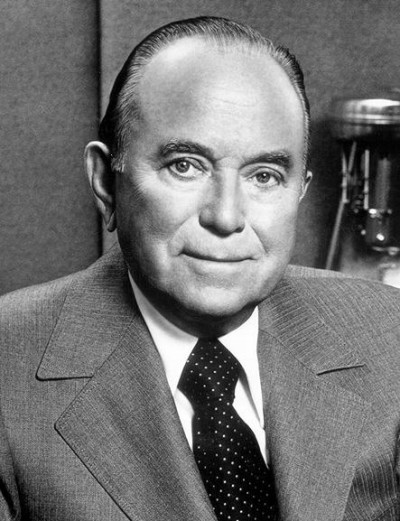Ray Kroc (Raymond Albert Kroc)

Kroc was born on October 5, 1902 in Oak Park, near Chicago, to parents of Czech origin, Rose Mary (Hrach) and Louis Kroc. His father was from the village Břasy near Plzeň, Bohemia (now the Czech Republic). He grew up and spent most of his life in Oak Park, Illinois. During the First World War he lied about his age and became a Red Cross ambulance driver at 15, though the war ended and unlike Walt Disney, who served a year in France, he was not shipped overseas. Between the end of the war and the early 1950s he tried his hand at a number of trades including paper cup salesman, pianist, jazz musician, band member and radio DJ at Oak Park radio station WGES. At one time, Ray worked for room and board at one of Ray Dambaugh’s restaurants in the midwest to learn the restaurant business.
With Prince Castle Multi-Mixer sales plummeting because of competition from lower-priced Hamilton Beach products, Ray took note of the McDonald brothers who had purchased 8 of his Multi-Mixers. Immediately after visiting the San Bernardino store, Ray became convinced that the setup of this small chain had the potential to explode across the nation. He offered his services to the McDonald brothers, who were looking for a new franchising agent following the departure of agent Bill Tansey due to health issues. Ray Kroc opened the first restaurant of McDonald’s, Inc. in Des Plaines, Illinois. Kroc remained active in Des Plaines until the end of his life, frequently phoning the manager of the store across the street to remind him to clean his restaurant properly. The Des Plaines location boomed, bringing in hundreds of dollars on its opening day. Ray franchised out scores of restaurants to franchisees. The brothers were satisfied with the money they had, and did not feel a need to expand their empire. Kroc became frustrated with the brothers’ desire to maintain a small number of restaurants. In 1961, he bought the company for $2.7 million (enough to pay each brother $1 million each after taxes). (When negotiating the contract the McDonald brothers said that 2% sounded greedy; 1.9% was more attractive.)
The agreement was a handshake with split agreement between the parties because Kroc insisted that he could not show the royalty to the investors he had lined up to capitalize his purchase. At the closing table, Kroc became annoyed that the brothers would not transfer to him the real estate and rights to the original unit. The brothers had told Kroc that they were giving the operation, property and all, to the founding employees. Kroc closed the transaction, then refused to acknowledge the royalty portion of the agreement because it wasn’t in writing. The McDonald brothers consistently told Kroc that he could make changes to things like the original blueprint (building codes were different in Illinois than in California), but despite Ray’s pleas, the brothers never sent any formal letters which legally allowed the changes in the chain. Kroc also opened a new McDonald’s restaurant near the McDonald’s (now renamed “The Big M” as they had neglected to retain rights to the name) to force it out of business.
After finalizing the agreement with the McDonald Brothers, Kroc sent a letter to Walt Disney. (They had met as ambulance driver trainees at Sound Beach, Connecticut.) Kroc wrote, “I have very recently taken over the national franchise of the McDonald’s system. I would like to inquire if there may be an opportunity for a McDonald’s in your Disney Development”. According to one account, Disney agreed under stipulation to increase fries from ten cents to fifteen cents allowing himself the profit. Kroc refused to gouge his loyal customers leaving Disneyland to open without a McDonald’s restaurant. Others believe that this is a ‘happy ending’ retelling of the Disney Story by some McDonald’s marketing executives. Most probably, the proposal was returned without approval.
Kroc maintained the assembly line “Speedee Service System” for hamburger preparation, which was introduced by the McDonald brothers in 1948. He standardized operations, ensuring every burger would taste the same in every restaurant. He set strict rules for franchisees on how the food was to be made, portion sizes, cooking methods and times, and packaging. Kroc also rejected cost-cutting measures like using soybean filler in the hamburger patties. These strict rules also were applied to customer service standards with such mandates that money be refunded to clients whose orders were not correct or to customers who had to wait more than 5 minutes for their food. However, Kroc let the franchisees decide their best approach to marketing the products. For example, Willard Scott created the figure now known internationally as Ronald McDonald to improve sales in the Washington, D.C. metropolitan area. Ray Kroc is used as an extensive example in George Ritzer’s sociological writings.
Kroc’s foundation supported research and treatment of alcoholism, diabetes, and other diseases. He established the Ronald McDonald House foundation. He was a major donor to the Dartmouth Medical School. In 1978, the 76-year-old Kroc suffered a stroke. He was required by doctors to take medication for his condition, and since it could not be used with alcohol, he had to enter AA rehab. He died of heart failure at a hospital in San Diego, California, on January 14, 1984 at the age of 81. He left a widow, Joan. His previous marriages, to Ethel Fleming (1922–1961) and Jane Dobbins Green (1963–1968), ended in divorce.
Born
- October, 05, 1902
- USA
- Oak Park, Illinois
Died
- January, 14, 1984
- USA
- San Diego, California
Cause of Death
- heart failure
Cemetery
- El Camino Memorial Park
- San Diego, California
- USA



